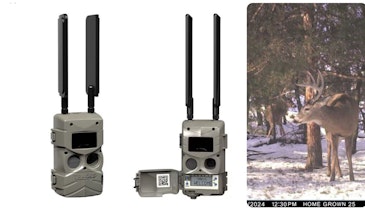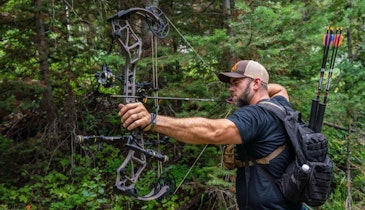For 2017, Mathews is doubling down on its Crosscentric Cam System, which is at the heart of all three of Mathews’ new bows, including the flagship Halon 32. Inspired by the No Cam system introduced two years ago, the Crosscentric Cam entails a partially concentric string payout to produce a smoother draw cycle as well as level nock travel. Mathews’ AVS design, which slaves the cams together to maintain synchronicity, is also incorporated into the Crosscentric system.
The combination of No Cam design elements and AVS technology is intended to achieve the very smooth draw cycle of the No Cam with the speed of the AVS design. RockMods, introduced last year, allow shooters to choose between 75 percent and 85 percent letoff. The higher letoff reduces speed slightly but gives the shooter the choice to hold what feels like nothing at full draw at the cost of a few feet per second in speed. Finally, as I pointed out in the test of last year’s original Halon, the oversized cams reduce string angle at full draw and in effect make the bow longer. This made the original compact Halon at 30 inches feel like a longer bow. That effect is enhanced by the longer 32-inch axle-to-axle length of the Halon 32, giving it the stability and overall feel of a target bow.

Other Features
The added length is a significant difference, to be sure, but apart from that new features are limited to a slightly different geometry in the riser cutouts, the use of Speed Nocks in place of the familiar Monkey Tails, and an all-black grip as opposed to the original Halon grip that featured a walnut insert where the logo appears. (The grip design, however, is the same FlatBack grip.) Also retained is the Harmonic Damper and the Harmonic Stabilizer in the riser, the Reverse Assist Roller Guard and the String Stop. The longer riser, apart from the previously discussed length and slightly modified cutouts, features the same dual-bridge design, and the Halon 32 also offers Mathews’ True Center nocking point. The wide quad limbs and limb pockets appear to be the same and, as with last year’s Halon, shooters have the choice of 5-inch, 6-inch or 7-inch brace heights. The added riser length adds slightly to the mass weight of the bow, getting it to 4.73 pounds for the 6- and 7-inch brace height versions of this bow, 4.83 pounds for the 5-inch version. That does not qualify as a light bow by any standards, but I will point out, as I did last year, that the weight no doubt adds to the stability, forgiveness and very low noise level of this bow.
The various brace heights naturally affect speed, with the top speed of 350 fps applying to the 5-inch brace height. The 6-inch version nonetheless achieves a very respectable top speed of 343 fps, with the 7-inch version coming in at 335 fps. Draw-length options vary slightly with brace height as well.
How the bow strikes you aesthetically will depend on how you feel about long riser/skinny brace height/big cams. The test bow was Lost Camo, a finish I’m partial to, and several other attractive camo options are new this year as well. The finish has a nice flat, textured feel to it. Fit and finish are never, in my experience, an issue with a Mathews bow, and this one proved no exception with no milling or machining marks or, for that matter, visible flaws of any kind.
Shooting the Bow
Set up proceeded without difficulty, though the limb bolts did chatter considerably when adjusted. Most of the flagship bows in today’s market tune easily compared to anything available a decade ago, but the Halon 32 is a stable bow that tunes even more quickly and easily than most. I quickly attained good arrow flight, and paper tuning for perfect bullet holes required only a few minor tweaks.
As mentioned, the Halon 32 is not a lightweight, and that is among the first things many shooters will notice. This might be a factor for some bowhunters who do a lot of spot-and-stalk hunting. For hunters sitting in a treestand or ground blind, a little extra weight is arguably a plus, since it makes for a more stable and forgiving shooting platform and reduces noise and vibration.
I do not always find the subjective perception of a draw cycle to match the draw force curve on paper, but in this case it does. The cycle is super smooth, building to peak weight fairly quickly, then leveling off to drop gradually into the valley and stop against a very firm back wall with no bumps or wrenches. A moderately wide valley means no grabbiness at full draw (even at 85 percent letoff), nor is the bow difficult to let down. In an era of very quiet bows, it is noticeably more quiet at the shot than most. The bow hops forward into a proper loose grip, but any vibration is barely detectable.
Overall, the feel and performance of the Halon 32 is, not surprisingly, similar to last year’s Halon. The additional length does make for less string pinch and added stability that some shooters will notice, especially at longer ranges, and the draw length that runs out to 31.5 inches on the 7-inch brace height model will make this bow more attractive to shooters with longer draw lengths. The Halon 32 is not a radical departure from last year’s models, but that clearly was not the aim here. Instead, a tweak here and a tweak there has made an already excellent bow just a little bit better.
For more information, visit www.mathewsinc.com.






